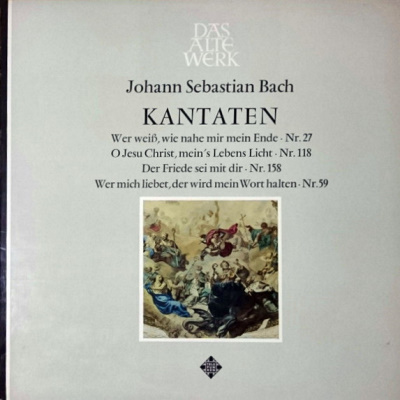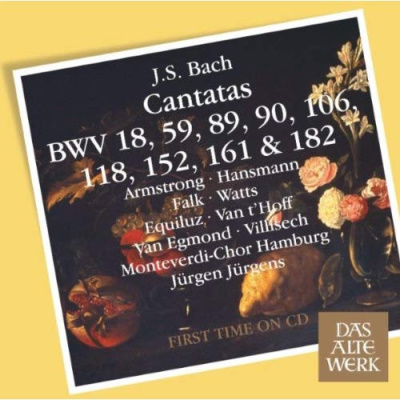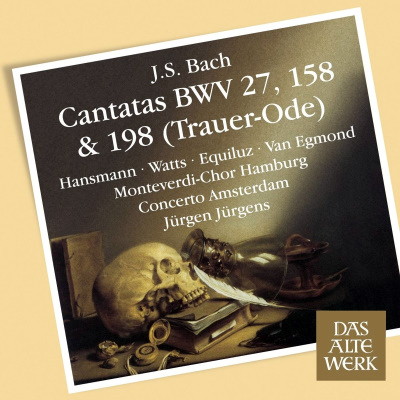 |
|
1 LP -
SAWT 9489-B - (p) 1968
|
 |
| 2 CDs -
2564-69599-2 - (c) 2008 |
 |
| 1 CD -
2564-64763-2 - (c) 2013 |
|
KANTATEN
|
|
|
|
|
|
|
|
| Johann Sebastian
BACH (1685-1750) |
Kantate
"Wer weiß, wie nahe mir mein Ende",
BWV 27 - Kantate am sechzehnten Sonntag
nach Trinitatis (Dominica 16 post
Trinitatis) |
|
17' 09" |
A1 |
|
für
Soli: Sopran, Alt, Tenor, Baß; Chor;
Oboe I/II; Oboe da caccia; Tromba; Orgel
(obligat); Violine I/II; Viola; Continuo |
|
|
|
|
- Chor: "Wer weiß, wie nahe mir
mein Endel"
|
4' 38" |
|
|
|
-
Recitativo (Tenor): "Mein Leben hat kein
ander Ziel"
|
0' 51" |
|
|
|
-
Aria (Alt): "Willkommen! will ich sagen"
|
5' 35" |
|
|
|
-
Recitativo (Sopran): "Ach, wer doch schon
im Himmel wär!" |
0' 59" |
|
|
|
-
Aria (Baß): "Gute Nacht, du Weltgetümmel!" |
3' 50" |
|
|
|
-
Choral (Chor): "Welt ade! ich bin dein
müde" |
1' 10" |
|
|
|
|
|
|
|
|
"O
Jesu Christ, mein's Lebens Licht",
BWV 118 |
|
|
|
|
Motette
zur Trauerfeier für den Reichsgrafen und
Gouverneur der Stadt Leipzig Joachim
Friedrich von Flemming (gest. 11. 1. 1740) |
|
3' 45" |
A2 |
|
für
Chor; Lituo (Horn) I/II; Cornetto (Zink
oder hohe Trompete); Trombone (Posaune)
I/II/III; Orgel |
|
|
|
|
|
|
|
|
|
Kantate
"Der Friede sei mit dir", BWV 158
|
|
11' 34" |
B1 |
|
Kantate
am Fest Mariä Reinigung oder am dritten
Osterfesttag (Festo Purificationis Mariae,
Feria 3 Paschatos) |
|
|
|
|
für
Solo-Baß; Chor; Oboe; Violine solo;
Continuo |
|
|
|
|
-
Recitativo (Baß): "Der Friede sei mit dir" |
1' 56" |
|
|
|
-
Aria - Choral (Baß, Sopran): "Welt ade!
ich bin dei müde" |
6' 34" |
|
|
|
-
Recitativo (Baß): "Nun Herr, regiere
meinem Sinn" |
1' 44" |
|
|
|
-
Choral (Chor): "Hier ist das rechte
Osterlamm" |
1' 17" |
|
|
|
|
|
|
|
|
Kantate
"Wer mich liebet, der wird mein Wort
halten", BWV 59 - Kantate zum ersten
Pfingstfesttag (Feria 1 Pentecostes)
|
|
10' 44" |
B2 |
|
für
Soli: Sopran, Baß; Chor*; Tromba I/II;
Timpani; Violine I/II; Viola; Continuo
(Cello, Baß, Orgel) |
|
|
|
|
-
Duett (Sopran, Baß): "Wer mich liebet, der
wird mein Wort halten" |
3' 55" |
|
|
|
-
Recitativo (Sopran): "O was sind das vor
Ehren" |
2' 06" |
|
|
|
-
Choral (Chor): "Komm, heiliger Geist, Herr
Gott!" |
1' 48" |
|
|
|
-
Aria (Baß): "Die Welt mit allen
Königreichen" |
2' 55" |
|
|
|
|
|
|
|
Rotraud Hansmann, Sopran
Helen
Watts, Alt
Kurt Equiluz, Tenor
Max van Egmond, Baß
MONTEVERDI-CHOR, HAMBURG
/ Jürgen Jürgens, Leitung
AMSTERDAMER KANTOREI (BWV 59)
Lilian Lagaay, Ad Mater, Oboe
Ad Mater, Oboe da caccia
Wim Groot, Fred Grin, Trompete
Hermann Baumann, Adriaan van
Woudenberg, Horn
Hans Maassen, Cees
Blokker, Jaap Klemann, Jacques
Banens, Posaune
Jaap Schröder, Solo-Violine
Anner Bylsma, Violoncello
Gustav Leonhardt, Orgel
CONCERTO AMSTERDAM
Jaap SCHRÖDER, Konzertmeister
|
|
|
|
|
|
Luogo
e data di registrazione |
|
Hervormde Kerk,
Bennebroek (Holland) - 1966/67
|
|
|
Registrazione: live
/ studio |
|
studio |
|
|
Producer |
|
Wolf Erichson
|
|
|
Prima Edizione LP |
|
Telefunken "Das Alte
Werk" | SAWT 9489-B | 1 LP -
durata 43' 12" | (p) 1968 | ANA
|
|
|
Edizione CD |
|
Warner Classics |
LC 04281 | 2564-69599-2 | 2 CDs
- durata 146' 05" | (c) 2008 |
ADD | (BWV 59, 118)
Warner Classics
| LC 04281 | 2564-64763-2 |
1 CD - durata 66' 44" | (c)
2013 | ADD | (BWV 27, 158)
|
|
|
Cover
|
|
Deckengemälde in der
Wallfahrtskirche zu Veresheim von
Maria Knoller.
|
|
|
Note |
|
-
|
|
|
|
|
|
The cantata in
the broadest sense of the
word - whether as the church
cantata or the patrician,
academic or courtly work of
musical homage and festivity
- accompanied the Arnstadt
and Mühlhausen organist, the
Weimar chamber musician and
court organist, the Köthen
conductor and finally the
Leipzig cantor of St.
Thomas’-Bach-all through his
creative life, although with
fluctuating intensity, with
interruptions and
vacillations that still are
problems to musicological
research down to this very
day. The earliest preserved
cantata (“Denn du wirst
meine Seele nicht in der
Hölle lassen”) probably
dates, if it really is by
Bach, from the Arnstadt
period (1704) and is still
completely under the spell
of North and Central German
traditions. In the works of
his Mühlhausen years
(1707-08) - psalm cantatas,
festive music for the
changing of the council and
a funeral work (the “Actus
tragicus”) - we sense for
the first time something of
what raises Bach as a
cantata composer so much
higher than all his
contemporaries: the ability
to analyse even the most
feeble text with regard to
its form and content, to
grasp its theological
significance and to
interpret it out of its very
spiritual centre in musical
“speech” that is infinitely
subtle and infinitely
powerful in effect. In
Weimar (1708-17) new duties
pushed the cantata right
into the background to begin
with. It was not until the
Duke commissioned him to
write “new pieces monthly”
for the court services that
Bach once more turned to the
cantata during the years
1714-16, on texts written by
Erdmann Neumeister and
Salomo Franck. Barely thirty
cantatas can be ascribed to
these two years with a
reasonable degree of
certainty. It is most
remarkable that, on the
other and no courtly funeral
music has been preserved
from the entire Weimar
period, although there must
have been a considerable
demand for such works. It is
conceivable that many a lost
work, supplied with a new
text by Bach himself, lives
on among the Weimar church
cantatas.
In the years Bach spent at
Köthen (1717-23), on the
other hand, it is the
composition of works for
courtly occasions of homage
and festivity that come to
the fore, entirely in
keeping with Bach’s duties
as Court Conductor. It is
only during the last few
months he spent at Köthen
that we find him composing a
series of church cantatas
once again, and these were
already intended for
Leipzig. It was in Leipzig
that the majority of the
great church cantatas came
into being, all of them -
according to the most recent
research - during his first
few years of office at
Leipzig and comprising
between three and a maximum
of five complete series for
all the Sundays and feast
days of the ecclesiastical
year. But just as suddenly
as it began, this amazing
creative flow, in which this
magnificent series of
cantatas arose, appears to
have ended again. It is
possible that Bach’s regular
composition of cantatas
stopped as early as 1726;
from 1729 at the latest it
is evident that other tasks
largely absorbed his
creative energy,
particularly the direction
of the students’ Collegium
Musicum with its perpetual
demand for fashionable
instrumental music. More
than 50 cantatas for courtly
and civic occasions have
indeed been recorded from
later years, but considered
over a period of 24 years
and compared with the
productivity of his first
years in Leipzig they do not
amount to very much. We are
left with the picture of an
enigmatic silence in a
sphere which has ever
counted as the central
category in Bach’s creative
output.
But we only need cast a
superficial glance at the
more than 200 of the
master’s cantatas that have
come down to us in order to
see that this conception of
their position in Bach’s
total output is fully
justified. Bach has
investigated their texts
with regard to both their
meaning and their wording
with incomparable
penetration, piercing
intellect and unshakeable
faith, whether they are
passages from the Bible,
hymns, sacred poems by his
contemporaries or sacredly
trimmed poetry for courtly
occasions. He has
transformed and interpreted
these texts through his
music with incomparable
powers of invention and
formation, he has revealed
their essence and, at the
same time, translated the
imagery and emotional
content of each of their
ideas into musical images
and emotions. The perfect
blending of word and note,
the combination of idea
synthesis and depiction of
each detail of the text, the
joint effect of the baroque
magnificence of the musical
forms and the highly
differentiated attention to
detail, the skillful balance
between contrapuntal,
melodic and harmonic means
in the service of the word
and, not least, the
inexhaustible fertility and
greatness of a musical
imagination that is able to
create from the most feeble
‘occasional’ text a world of
musical characters - all
this is what raises the
cantata composer Bach so
much higher than his own and
every other age and their
historically determined
character, and imparts a
lasting quality to his
works. It is not their texts
alone and not their music
alone that makes them
immortal - it is the
combination of word and note
into a higher unit, into a
new significance that first
imparts to them the power of
survival and makes them what
they are above all else:
perfect works of art.
Wer Weiß, wie nahe mir
mein Ende! (BWV 27) is
linked, like the cantata
just discussed, to a Gospel
narration of an avvakening
from the dead (Luke 7:
11-17) - this time of the
young man in Nain, The idea
which the author of the text
has developed is basically
the same as before: Jesus
will awaken me and
therefore, he reasons, my
fear of death (dealt with in
the first and second
movements) is groundless; on
the contrary, death can only
be welcome to me. The
poetry, which recalls an
aria text by Erdmann
Neumeister in the third
movement (Neumeister:
"Wilkommen! will ich sagen,
so bald der Tod ans Bette
tritt..." remains free of
both didacticism and baroque
exaggerations, and is
distinguished instead by a
warmth of feeling that
places it among the most
successful texts ever set by
Bach. Bach's composition was
written for October 6, 1726,
and thus belongs to the
third of the yearly cycles
that have been preserved.
Although it begins with a
chorale, it is not a chorale
cantata: the inner movements
are not paraphrasos of a
hymn, nor do the opening and
closing chorales belong to
the same hymn. ln the
opening chorus the hymn tune
(”Wer nur den lieben Coll
läßt walten" - Who but lets
the dear God rule) is worked
into a meditative
instrumental texture with a
theme of its own (though
remotely related to the
chorale). Bach, however,
modifies this manner of
writing, wellknown from the
chorale cantatas, by the
inclusion of recitative
inserts in which the
motif-based orchestral
writing and the fixed meter
of the text are maintained.
This is the only example of
a recitative in three-four
time in the whole of Bach!
The first aria (movement 3)
is of unusual charm, and
requires as obbligato
instruments an oboe da
caccia and an obligato
harpsichord, which was
evidently replaced by an
obbligato organ at a later
performance. With its simple
song melody, Bach has found
just the right setting for
the character of its text,
and that of the entire
cantata. The second aria
movement in the cantata
(movement 5) is based on the
contrast of concepts ”Gute
Nacht - Weltgetümmel” (Good
night - wordly bustle),
which it also maintains
consistently in the music.
The initial Sarabande rhythm
is basically kept going
throughout the piece, but
already in the second half
of the ritornello and the
main section of the aria it
is filled out with lively
sixteenth-note figuration,
only the middle section and
the end of the last
ritornello being kept free
of this. Contrary to his
usual practice, Bach has
adopted a five-part setting
by Johann Rosenmüller as the
final chorale.
The occasion for which Bach
wrote his motet O Jesu
Christ, mein’s Lebens
Licht (BWV 118) is
unknown, but it may have
been for a Leipzig
University funeral service
during the mid-1730s. The
text is by Martin Böhme.
That the funeral ceremony
took place in the open air
is suggested by the
instrumentation, reminiscent
of older musical practices
and most unusual for Bach,
with two high horns,
cornetto, three trombones
and no continuo part. The
instrumental accompaniment
is so laid out that in spite
of a great degree of
independence it is able to
support the choir whenever
it enters. Simple harmonic
relationships and
uncomplicated part-writing
distinguish the movement,
whose effectiveness lies in
its instrumentation and
simplicity.
Der Friede sei mit dir
(BWV 158) is one of
Bach’s unusual cantatas, not
least because of its brevity
and sequence of movements.
Neither the author of the
text nor the circumstances
of its composition are
known, and the cover of the
score, which only exists as
a copy, names the Third Day
of Easter and the feast of
Candlemas (the Purification
of the Virgin) as the
liturgical occasions for
which the cantata was
intended. Cantata No. 158
probably consists of a
number of parts, and only a
fragment has survived. Our
knowledge of Bach cantatas
suggests that a seconcl aria
at least is missing before
the final chorale. The focal
point of the work is the
great bass aria with solo
violin ”Welt ade! ich bin
dei müde," to which the
soprano sings the chorale of
the same name line-for-line.
In its instrumental
symbolism and expressive
power the writing here is
related to the aria "Erbarme
dich” from the later St
Matthew Passion.
Wer mich liebet, der wird
mein Wort halten (BWV 59)
was intended for the First
Day of Whitsuntide and was
probably performed in 1724
in the Leipzig University
Church. This venue
presumably explains the
modest instrumentation of
the work, its extremely
unusual form and the
singular fact than in this
instance Bach composed only
the first four movements from
a text by Erdmann Neumeister
(from the latter’s fourth
annual cycle of cantatas for
1714). Perhaps Bach himself
felt the work to be
unsatisfactory, for a year
later it was expanded into
the large Cantata BWV 74 for
Whit Sunday. The first
movement is just as unusual
as the whole of the work.
The text, a quotation from
the Sunday Gospel, is
rendered four times in
canonic form, until
eventually the two soloists
come together in parallel
sixths; around this nucleus
strings and trumpets (two
instead of the usual three)
weave a fine
chamber-music-like setting
which continually reverts to
the two core motifs of the
vocal parts. The contrast
between the symbolic
strictness of the vocal
movement and the concertante
freedom of the instruments
seems in turn to have a
symbolic intention. The
recitative that follows
proceeds from A minor to the
G major of the succeeding
chorale; a harmonically rich
string accompaniment,
ecstatic exclamations and
the quick vocalises of the
concluding arioso
give this movement a hint of
rapturous exuberance that
establishes a link with the
chorale, of which this
exuberance is a natural
part. The bass aria with
obbligato violin combines a
concise ritornello
arrangement (ritornello -
first text section a a b -
ritornello, abbreviated -
second text section c d e -
ritornello) with a markedly
contrasting representation
of the two text sections.
Catchy, song-like melody is
used to juxtapose secular
and divine glory, while
expansive, emotional
melisrnas convey the bliss
of eternal life.
|
  |
|
|